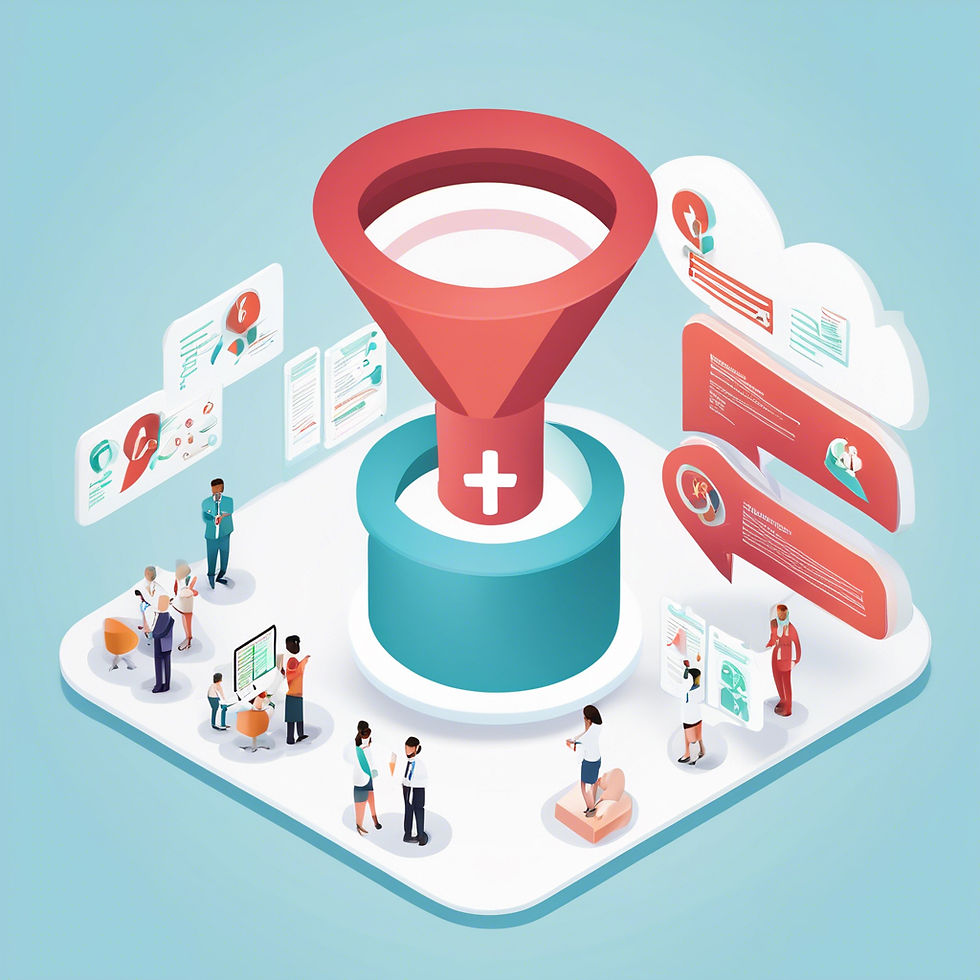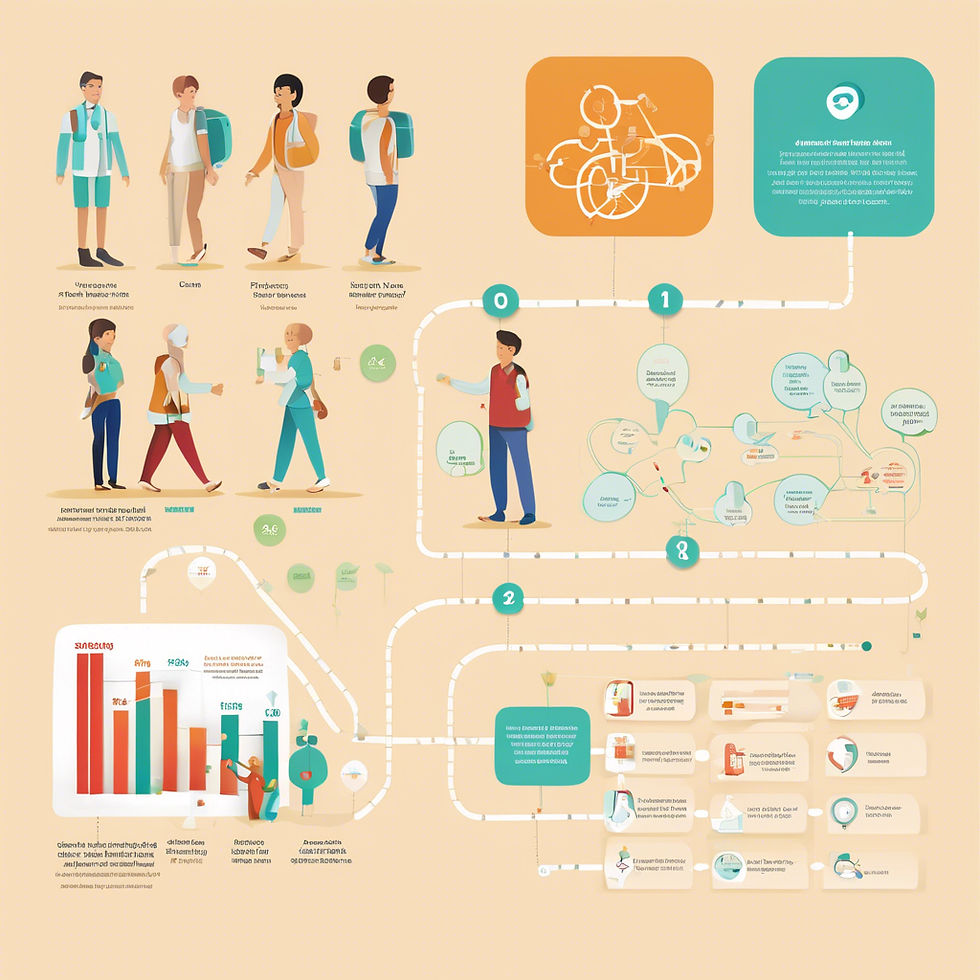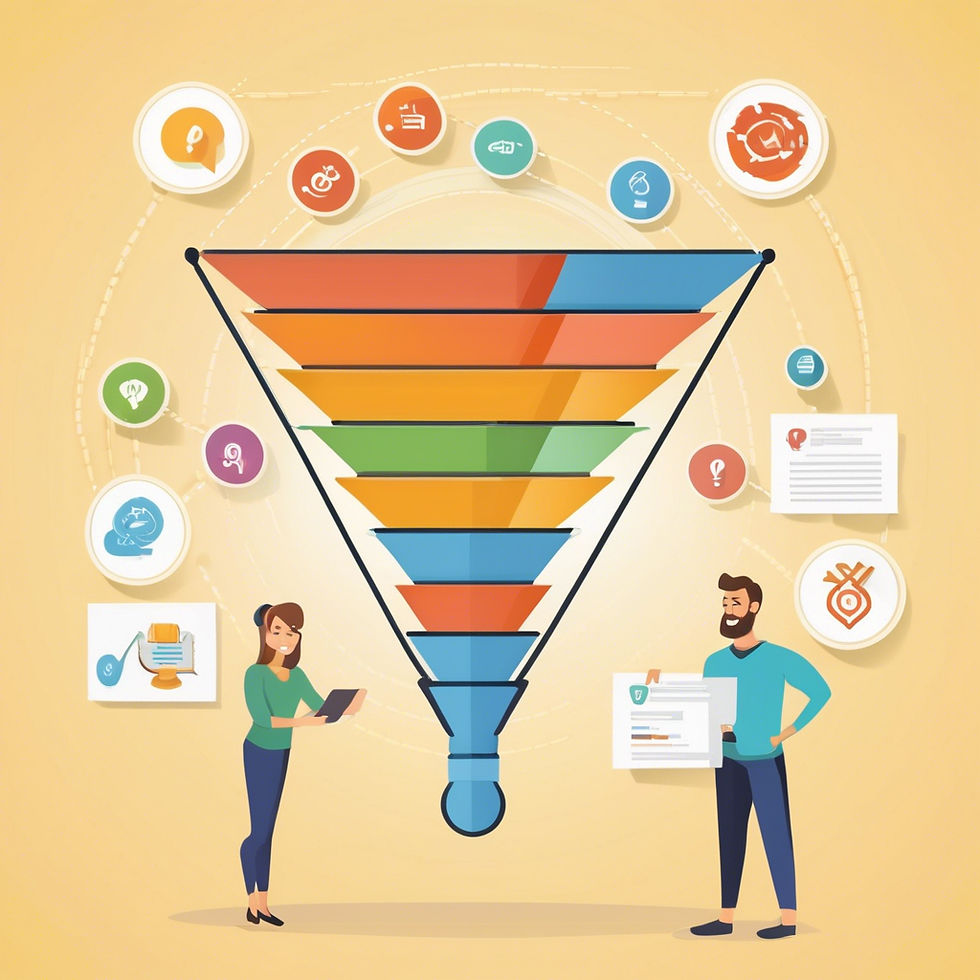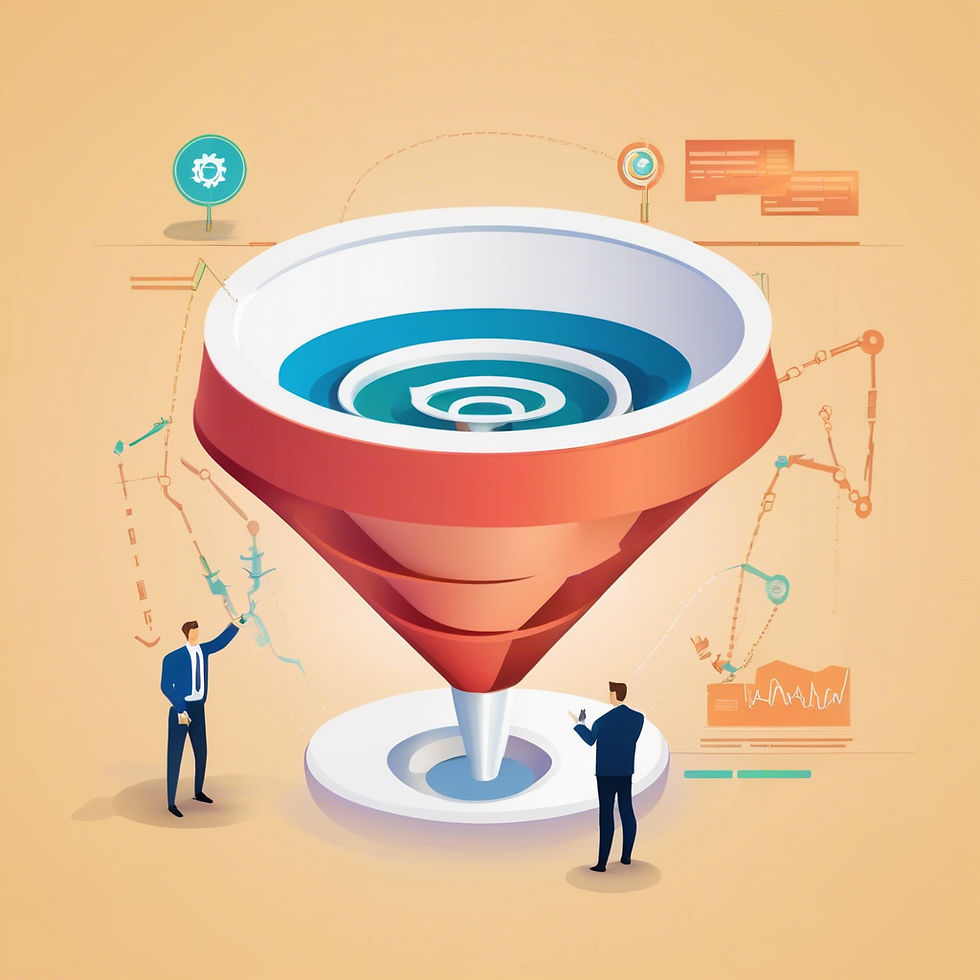Content Marketing Funnel Breakdown in Healthcare (Explained) A Deep Dive
- Eldon Riley

- 3 days ago
- 11 min read
Content marketing in healthcare is vital for reaching patients. It guides them through a journey, from awareness to action.
Understanding the content marketing funnel can help healthcare providers connect effectively with their audience. A content marketing funnel breaks down the stages of a patient's journey. It starts from becoming aware of healthcare services to making informed decisions. For healthcare providers, this funnel is essential to build trust and educate patients.
By mapping out each stage, providers can deliver targeted content that addresses patient needs at each point. This approach ensures that patients receive the right information when they need it, fostering better engagement and satisfaction. Dive into this guide to learn how to optimize your content marketing funnel in healthcare and enhance patient interactions.

Introduction To Content Marketing Funnel
Understanding the content marketing funnel in healthcare can improve patient engagement. Each stage guides potential patients from awareness to decision-making effectively. Simplified strategies ensure better connections and trust.
Introduction to Content Marketing Funnel Navigating the healthcare industry can be daunting, both for providers and patients. One way to simplify this journey is through an effective content marketing funnel. This funnel guides potential patients from the awareness stage to becoming loyal advocates of your healthcare services.
Importance In Healthcare
Content marketing in healthcare is not just about attracting more patients. It's about educating them and building trust. When patients trust you, they're more likely to follow your advice and remain loyal. Healthcare decisions are often crucial and anxiety-inducing. A well-structured content marketing funnel can alleviate these concerns. It provides reliable information at each stage, helping patients make informed decisions.
Benefits For Providers And Patients
For providers, a content marketing funnel can streamline patient acquisition. It targets the right audience with relevant content, ensuring higher engagement and conversion rates. This means more patients who are well-informed and ready to take action. Patients benefit from a wealth of information tailored to their needs.
From understanding symptoms to exploring treatment options, the funnel offers valuable insights. This empowers patients to take control of their health journey. Imagine you're looking for a new healthcare provider. You start with a Google search and land on a blog post about common symptoms. As you read, you find links to more in-depth articles and patient testimonials. This content guides you through the decision-making process seamlessly.
Tip: Regularly update your content to address new medical advancements and patient concerns. This keeps your funnel relevant and trustworthy. Have you ever found yourself overwhelmed by medical information online? How did you navigate through it? A well-crafted content marketing funnel can make all the difference, offering clear, reliable guidance. In summary, understanding and implementing a content marketing funnel in healthcare can lead to better patient outcomes and a more efficient practice. It's a win-win for everyone involved.
Top Of The Funnel (tofu)
Top of the Funnel (TOFU) content in healthcare aims to attract and educate a broad audience. It includes blog posts, informational videos, and social media updates.
When diving into content marketing for healthcare, the Top of the Funnel (TOFU) is crucial. This is where potential patients first encounter your brand. Your goal here is to raise awareness and attract a broad audience. Let's break down how you can make this stage effective and engaging.
Raising Awareness
At the TOFU stage, your primary aim is to introduce your healthcare services. You want to connect with people who may not even know they need your services yet. This is where you cast a wide net. Imagine someone scrolling through social media and stumbling upon an article about common health issues.
They might not be actively seeking healthcare services, but now they are aware of potential problems and solutions. Creating content that educates and informs is key here. Think about the questions your potential patients might have. What are common symptoms they might be ignoring? Address those in your articles, videos, or social media posts.
Engaging Content Types
Different types of content can be highly effective at this stage. Blog posts, infographics, and social media updates are great ways to share bite-sized, valuable information. Short videos explaining medical conditions or wellness tips can grab attention quickly.
People love visuals, so make your content visually appealing. Interactive content like quizzes can also be a hit. For example, a quiz that helps users assess their health can be both fun and informative. It engages them and gives them a reason to share their results, spreading your reach further. Remember, the goal is to provide value without overwhelming your audience. Keep it simple yet informative.
What kind of content do you find most engaging? Think about that and apply it to your strategy. By focusing on raising awareness and using engaging content types, you set a strong foundation for the rest of your content marketing funnel. Start strong, and you’ll attract a wide audience ready to learn more about what you offer.

Middle Of The Funnel (mofu)
Middle of the Funnel (MOFU) nurtures interested healthcare prospects with detailed information. Guides them closer to making an informed decision.
The Middle of the Funnel (MOFU) is a crucial stage in the content marketing funnel, especially in the healthcare industry.
At this point, potential patients are aware of their problems and are looking for more information to make informed decisions. This is where you need to build trust and provide educational content that addresses their specific needs.
Building Trust
Building trust at the MOFU stage is essential. People are more likely to choose healthcare services that they feel confident about. You can build trust by sharing patient testimonials and case studies. Imagine you are looking for a new doctor. Wouldn't you feel more reassured if you read about other patients' positive experiences?
Adding genuine testimonials can make a big difference. Another way to build trust is through transparent communication. Explain procedures, risks, and benefits clearly. This openness helps potential patients feel more secure in their decision-making process.
Educational Content Strategies
Educational content is key at this stage. Potential patients are looking for detailed information to understand their conditions and treatment options. Create blog posts, videos, and infographics that explain complex medical terms in simple language. This helps to make the information accessible to everyone.
Offer downloadable resources like e-books or guides. These can provide in-depth knowledge and serve as valuable reference material for potential patients. Webinars and Q&A sessions are also great. They give people a chance to interact with healthcare experts and get their questions answered directly. This not only educates but also builds a personal connection.
Think about the last time you attended a helpful webinar. Didn’t it make you feel more informed and connected to the speaker? Applying this strategy can have the same effect on your audience. In summary, the MOFU stage is all about building trust and providing valuable educational content. By focusing on these aspects, you can guide potential patients closer to choosing your healthcare services. What strategies will you implement to enhance your MOFU content?
Bottom Of The Funnel (bofu)
The Bottom of the Funnel (BOFU) is a critical stage in the content marketing funnel for healthcare. At this stage, your audience is ready to make a decision. They have evaluated their options and are leaning towards a final choice. Your goal is to provide the right information to help them choose your healthcare services.
Encouraging Decisions
At BOFU, your content should address any final concerns. Provide detailed information about your services. Highlight unique benefits and success stories. Use testimonials and case studies. These build trust and show real-life outcomes.
Offer detailed guides. Break down procedures and treatments. This helps potential patients understand what to expect. Make the information clear and easy to digest. Use simple language and avoid medical jargon.
Effective Call-to-actions
Your call-to-actions (CTAs) need to be clear and compelling. Encourage users to take the next step. Use phrases like "Book an Appointment" or "Schedule a Consultation." Make these CTAs prominent on your page. Ensure the process is simple. The fewer steps, the better. A complicated process can discourage potential patients.
Provide multiple ways to contact you. Phone, email, and online forms are good options. Use urgency in your CTAs. Phrases like "Limited Spots Available" can prompt quicker decisions. Ensure your contact information is easy to find. Place it at the top and bottom of your pages.

Patient Journey Mapping
Patient journey mapping is essential for effective content marketing in healthcare. It helps understand patients' experiences and needs. By mapping their journey, healthcare providers can create relevant content. This ensures each stage of the patient journey is addressed.
Identifying Touchpoints
First, identify key touchpoints in the patient journey. These are moments where patients interact with healthcare services. Examples include scheduling an appointment, visiting a clinic, or getting lab results. Knowing these touchpoints helps tailor content to patient needs. It ensures the right information reaches patients at the right time.
Tailoring Content For Stages
Each stage of the patient journey requires different content. In the awareness stage, patients seek information about symptoms or conditions. Create educational content to inform and guide them. During the consideration stage, patients compare treatment options. Provide detailed information on treatments and their benefits.
In the decision stage, patients are ready to choose a healthcare provider. Offer testimonials, case studies, and success stories. This builds trust and confidence. After treatment, patients need follow-up care and support. Share aftercare tips, recovery plans, and support group information.
Measuring Success
Measuring success in content marketing for healthcare is crucial. It helps determine if your strategies are effective. This involves tracking various metrics and using analytics tools. Let's break down the key components of measuring success in a content marketing funnel for healthcare.
Key Performance Indicators
Key Performance Indicators (KPIs) are essential for measuring success. KPIs help track progress and identify areas for improvement. In healthcare, some important KPIs include:
Website Traffic: Track the number of visitors to your site.
Engagement Rate: Measure how users interact with your content.
Conversion Rate: Monitor the percentage of visitors who become patients.
Lead Generation: Count the number of new leads generated.
Patient Retention: Track the number of returning patients.
These KPIs provide a clear picture of your content marketing performance. Regularly review these metrics to ensure your strategy is on track.
Analytics Tools
Using analytics tools is essential for measuring success. These tools help gather and analyze data. Some popular analytics tools for healthcare include:
Google Analytics: Track website traffic and user behavior.
HubSpot: Monitor lead generation and conversion rates.
Hootsuite: Manage and analyze social media performance.
SEMrush: Track keyword rankings and SEO performance.
Crazy Egg: Analyze user interactions with heatmaps.
These tools provide valuable insights into your content marketing efforts. Use them to make data-driven decisions and optimize your strategy.

Case Studies In Healthcare
Understanding how content marketing funnels work in healthcare is essential for creating effective campaigns. One way to grasp the intricacies is by examining real-world examples. Let's dive into some compelling case studies that highlight successful campaigns and the lessons learned from them.
Successful Campaigns
One notable campaign involved a healthcare provider focusing on diabetes management. They created a multi-step content funnel starting with informative blog posts about diabetes care. Engaging infographics and patient stories were used to capture attention and build trust.
They then offered a free downloadable guide on diabetes-friendly recipes, capturing leads through email subscriptions. This was followed by a series of nurturing emails providing valuable tips and promoting their diabetes management program. The result? A significant increase in patient sign-ups and improved patient engagement.
Another success story comes from a mental health clinic. They produced a series of videos addressing common mental health issues. These videos were shared on social media and embedded in blog posts on their website. Each video included a call-to-action encouraging viewers to book a free consultation.
This approach not only drove traffic to their website but also increased the number of consultations. The personal touch of video content helped build trust and made potential patients feel more comfortable seeking help.
Lessons Learned
From these campaigns, several key lessons emerge. First, it's crucial to provide valuable content that addresses your audience's specific needs. General information won't cut it; you need to be specific and actionable.
Second, using a mix of content types—blogs, videos, infographics—can cater to different preferences and increase engagement. People consume information differently, so diversify your content to reach a broader audience.
Third, always include clear calls-to-action. Whether it’s downloading a guide, subscribing to a newsletter, or booking a consultation, guide your audience on the next steps. Don't leave them wondering what to do next. Lastly, follow up with your leads. Nurturing emails or follow-up calls can make a huge difference in converting leads into patients. Consistent communication builds trust and keeps your service top of mind.
How can you apply these lessons to your content marketing strategy? Think about the specific needs of your audience and how you can meet them through valuable content. What types of content will resonate most with them? And most importantly, how will you guide them through each stage of your content marketing funnel?
Future Of Content Marketing In Healthcare
The future of content marketing in healthcare is shaping up to be dynamic and transformative. As technology advances, healthcare providers are finding innovative ways to engage with patients and audiences. The focus is shifting towards creating personalized, relevant, and valuable content that meets the evolving needs of healthcare consumers.
Emerging Trends
One of the most exciting trends is the use of AI and machine learning to create personalized content. Imagine receiving health tips and reminders tailored specifically to your medical history and preferences. This isn’t just a futuristic dream—it's happening now.
Another trend is the increased use of video content. More healthcare providers are leveraging video tutorials, patient testimonials, and live Q&A sessions to build trust and offer valuable information. Videos are highly engaging and can convey complex information more effectively than text.
Telemedicine is also driving new content marketing strategies. With more patients opting for virtual consultations, healthcare providers are creating content that guides patients on how to use telehealth services effectively. This not only improves patient experience but also enhances engagement.
Innovative Approaches
Interactive content is gaining traction. Quizzes, polls, and interactive infographics are being used to engage users and provide personalized insights. For instance, a quiz about symptoms can guide patients on the next steps for seeking care.
Content that builds community is also becoming crucial. Online forums, social media groups, and community events are used to create a sense of belonging among patients. Sharing personal stories and experiences can offer support and valuable insights to others in similar situations. Lastly, transparency and authenticity are now more important than ever.
Patients want to see real-life case studies, honest reviews, and transparent communication from their healthcare providers. Being open and authentic helps build trust and credibility, which is essential in the healthcare sector.
How do you see these trends and approaches impacting your experience with healthcare content? Are there any specific innovations that you find particularly beneficial or intriguing?

Frequently Asked Questions
What Are The Stages Of The Content Marketing Funnel?
The stages of the content marketing funnel are: awareness, consideration, conversion, loyalty, and advocacy. Each stage nurtures the customer journey.
What Is Content Marketing In Healthcare?
Content marketing in healthcare involves creating valuable, relevant content to educate and engage patients, improve health outcomes, and build trust.
What Are The 5 P's Of Healthcare Marketing?
The 5 P's of healthcare marketing are Product, Price, Place, Promotion, and People. These elements help healthcare providers effectively reach and engage their target audience.
What Are The 5 Stages Of The Marketing Funnel?
The 5 stages of the marketing funnel are Awareness, Interest, Consideration, Intent, and Purchase. Each stage guides potential customers from learning about your product to making a purchase. Effective marketing strategies address the needs of customers at each stage.
Conclusion
A well-structured content marketing funnel is crucial in healthcare. It guides potential patients smoothly. Each stage nurtures trust and engagement. Clear, informative content helps build connections. Remember to address patient needs and concerns. Personalization enhances patient experience.
Measure and adjust strategies regularly. Effective content marketing leads to better patient outcomes. Start refining your healthcare marketing funnel today. Your audience awaits meaningful engagement.
Let’s Build Your Success Together
Don’t wait for results to happen—create them. With URDigital Tech, you’re not just getting a service; you’re gaining a partner invested in your success.
Email us at: solutions@urdigitaltech.com
Text us at: (716) 400-0769
Contact us today to see how we can help you turn ideas into impact and opportunities into achievements.





Comments